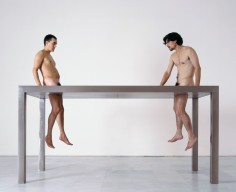Javier Codesal
Inmóviles
source: museoreinasofiaes
Javier Codesal’s (Sabiñánigo, 1958) exhibition in Espacio Uno consists of two specific projects that have the body as the protagonist element and support of an analysis of the difficulty of human communication.
Codesal is considered one of the pioneers of video art practice in Spain. His works, in the words of the critic and curator Manel Clot, “incorporate a presumable concept of dematerialisation inherent in the execution of all performative processes -videorecording, photographing- and a strong disassociation with the traditional narrative media.”
In the installation Inmóviles the centre of the room is occupied by a metal table of oversized proportions, which has two pairs of openings on its cold surface. More than a conventional table it alludes to a surgical table.
Fourteen photographs are displayed along the walls of the room which show a scene that takes place in this space: the unsuccessful attempts of two men to make contact. Their legs sink into these openings and, given the size of the table the men do not manage to reach the ground with their feet.
The suspension of their bodies becomes a metaphor for suspended communication “the break-up of the meeting”, as noted by the artist. At the same time, the photographs are an image of the demonstrative process of the impossibility of abstract sense.
The intensity of the work lies in the spatial alteration that the enormous table generates, whose presence is reinforced by the absence of occupants, who thus accept their loss to this device.
The second work in this exhibition: Fábula de un hombre amado, is a video installation comprising of two projections on separate screens, placed perpendicular to the wall. In this way, it is possible to view on both sides and “a complex three-dimensional device designed to implement production mechanisms of meaning in the hall” is configured, as noted by Manel Clot.
In this sense, while the choice of the term fable might make the public think of an artificial or exemplary narrative, the artist shows a sequence of spontaneous visual material, whose narrative is not linear, but lyrical, in such a way that it triggers the production of meanings for each of the images.
.
.
.
.
.
.
.
source: congresamp2014
Javier Codesal, artista plástico e poeta espanhol, é um pioneiro na arte de vídeo. Ele explora com sua câmera esta zona instável, onde se vislumbram os limites: a dor, a doença e a morte. “A dor é um testemunho preciso que delimita os territórios, tanto no exterior como no interior de nós mesmos”, disse ele.
Segundo ele, a arte tenta fazer a carne, dar corpo, e encontra o vazio. Por vezes, tem-se a impressão de ter capturado alguma coisa que se pode tocar com a imagem. Então, temos a impressão de que há algo do vivo. “No ato criativo, há sempre algo que rateia. Mas há também algo que é bem sucedido. Pelo menos, quando se canta, algo se localiza …”.
.
.
.
.
.
.
.
source: casasinfin
Javier Codesal nace en Sabiñánigo, Huesca, en 1958. Es uno de los creadores españoles más interesantes de la actualidad. Para su trabajo –desplegado muchas veces en forma de instalaciones o series– se sirve tanto de del cine como de la fotografía, el vídeo y la poesía. En 2009 el Centro de la Imagen La Virreina, de Barcelona, le dedicó una importante retrospectiva a su obra bajo el título Dentro y fuera de nosotros, y diez años antes, en 1999, el Espacio Uno del Museo Reina Sofía lo consagró como uno de los principales videoartistas de su generación. Ha participado en numerosas exposiciones individuales como Los nombres del padre II, Centro de Arte Pepe Espaliú (Córdoba, 2013); Mario y Manuel, Diputación de Huesca (Huesca, 2005); El monte perdido, Galería Estrany-de la Mota (Barcelona, 2004); La piel vuelta, Palacio de Abrantes (Salamanca, 2000); y en exposiciones colectivas como Los pies que faltan, La Mar de Músicas, Sala Muralla Bizantina (Cartagena, 2010); Muestra de vídeo de autor español, MUA (Alicante, 2008) El discreto encanto de la tecnología. Artes en España, MEIAC (Badajoz, 2008) y ZKM (Karlsruhe, Alemania, 2008). También ha publicado libros de poesía Ha nacido Manuel (Icaria, 2005); Imagen de Caín (Icaria, 2002); Feliz humo (reeditado en Periférica, Cáceres, 2009); y un ensayo sobre su obra cinematográfica Dos películas (en coedición con Periférica y Casa sin Fin, Cáceres, 2010).
.
.
.
.
.
.
.
source: casasinfin
He was born in Sabiñánigo, Huesca, in 1958. He usually works in large projects that may include videos, photographs, texts or drawings. In 2009, a major retrospective of his work was held at the Centro de la Imagen La Virreina, under the title “Inside/Outside Us”; ten years before in 1999, MNCAR’s Espacio Uno consacrated him as one of the most important videoartists of his generation. He has participated in many individual exhibitions such as the
Los nombres del padre II, Centro de Arte Pepe Espaliú (Cordova , 2013); Mario y Manuel, Diputación de Huesca (Huesca, 2005); El monte perdido, Estrany-de la Mota Gallery (Barcelona, 2004); La piel vuelta, Palacio de Abrantes (Salamanca, 2000); and in collective shows as Los pies que faltan, La Mar de Músicas, Sala Muralla Bizantina (Cartagena, 2010); Muestra de vídeo de autor español, MUA (Alicante, 2008) El discreto encanto de la tecnología. Artes en España, MEIAC (Badajoz, 2008) y ZKM (Karlsruhe, Germany, 2008). He has also published poetry books Ha nacido Manuel (Icaria, 2005); Imagen de Caín (Icaria, 2002); Feliz humo (published in Periférica, Cáceres, 2009); and the essay on his cinematic work Dos películas (a coedition by Periférica and Casa sin Fin, Cáceres, 2010).


